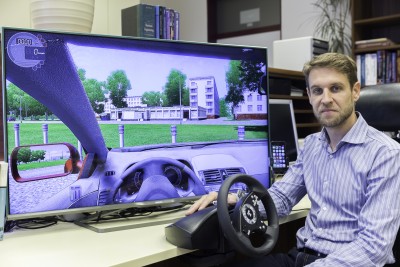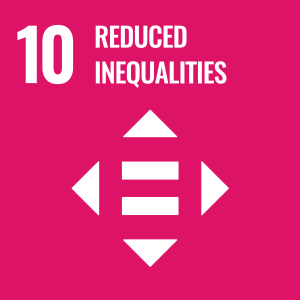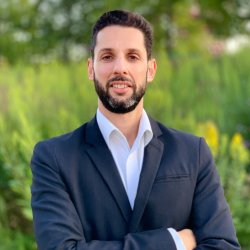Driving safety: Q&A with Professor Jaka Sodnik
Professor Jaka Sodnik of the University of Ljubljana, Slovenia, is on a mission to reduce the number of car accidents among older drivers – and he’s come to Surrey to build and test a unique simulator that could hold the answer.
Elderly people tend to drive less than younger ones but have a higher incidence of accidents per mile on average. However there is currently no systematic assessment tool for motor and cognitive skills which medical experts such as GPs can use, when needed, to determine whether to approve driving license extensions.

Professor Sodnik has brought his driving simulator – SimFit2Drive – onto campus and is collaborating with Dr Nikolas Thomopoulos, Associate Professor in Transport, to prove the concept and explore opportunities. This month Professor Sodnik is visiting Surrey for the third time, funded by an Institute of Advanced Studies (IAS) Fellowship. Through this Fellowship scheme academics, artists-in-residence, entrepreneurs and public servants from around the world come to the University to work with our academics on a fascinating range of research topics.
Professor Sodnik explains what he hopes to achieve through his collaboration with Surrey.
What inspired you to develop SimFit2Drive?
It started with a research project I was involved with in Slovenia which aimed to develop a driving simulator to educate young drivers. A rehabilitation institution then asked whether we could use a similar system to test elderly drivers with cognitive impairment and the idea for SimFit2Drive was born.
Why do we need this?
As we get older there’s a decline in our vision, reaction times, motor and cognitive skills and for some people, this decline reduces their ability to drive safely. If you look at a graph of driving accidents, there’s a U-shaped curve with the youngest and oldest drivers involved in the most casualties per mile. But whereas young people undergo a driving test, older drivers do not, so that is where we have focused our attentions.
There is no unified solution to this problem across Europe. For example in the UK people over 70 are meant to self-report any health issues to the DVLA but there is no actual test, whereas in Slovenia drivers are given basic tests at 65 and the relevant legislation is currently being revised to add new requirements. The European Commission is actively looking for a solution to this problem, so this piece of technology is very timely.
Tell us about the driving simulator…
The simulator is currently located in the Department of Tourism and Transport and it’s designed to make you feel as if you’re driving a real car – with a steering wheel, gear stick and so on, and big screens which simulate all kinds of driving conditions.
The system tests users’ reactions by asking them to respond to specific stimuli and then measures their physical agility – for example whether they have enough force to steer the wheel and press the brake. Finally it tests their cognitive skills by putting them in a driving scenario where they need to follow the speed limit and perform manoeuvres such as changing lanes.
The technology which currently exists for testing people’s driving is fairly basic, only measuring force, so this technology is a big step forward.
What’s your research background?
I’m originally an electrical engineer and now specialise in human machine interaction with a focus on vehicles.
How did you meet your IAS Fellowship host, Dr Nikolas Thomopoulos?
We met at a meeting of WISE-ACT, a global network of experts focused on the wider impact of autonomous vehicles. I’m interested in how to make vehicles safer and part of that is understanding human behaviour, so Nikolas’s expertise in socio-economic and business challenges as well as transport was very interesting.
What have been the highlights of your Fellowship so far?
The most important thing we’ve achieved is setting up the simulator on campus. This was a big logistical challenge because it meant transporting the components – which weighed half a tonne! – from Slovenia. Once the simulator was up and running we were able to conduct some initial tests which built on existing research from Slovenia.
The other highlight was organising a workshop where we demonstrated the simulator to the biggest national assessor of elderly drivers in the UK, Queen Elizabeth Foundation (QEF), part of Driving Mobility, along with other important stakeholders. The reaction we got was very good – QEF were thrilled to see what we are doing as it aligns with their own work.
And what are the next steps?
We’re about to do a study with around 20 participants of different ages with no known cognitive problems which will give us a baseline from the general population. This will enable us to identify when drivers’ results fall outside normal parameters – we believe the simulator should be able to determine this with 90-95% accuracy.
In our ageing society we think this technology could improve driving safety on a European or even an international level, as well as providing vital support for health experts who are required to assess elderly people’s ability to drive.
We have been looking to commercialise the simulator and also working with national institutions to help set driving standards.
How would you describe your IAS Fellowship experience?
It’s been an excellent experience. I really like the campus and surrounding area and I’ve had the chance to get to know students and staff. I’ve given a guest lecture to tourism and transport undergraduates and a seminar to staff and PhD students in the School of Hospitality and Tourism Management – in both cases it’s been interesting to get the perspectives of a non-engineering audience and we are now thinking about how simulator use could support tourism.
Although I’ve been involved in many international collaborations before, the IAS Fellowship has enabled me to engage with a well-known UK university over a longer period which has been exciting. Dr Thomopoulos and I definitely plan to carry on collaborating after the Fellowship ends!
Related sustainable development goals



